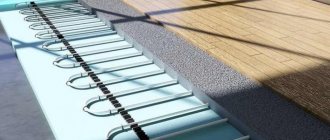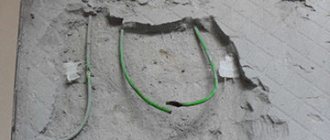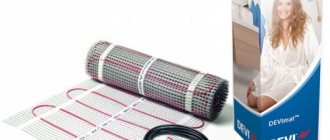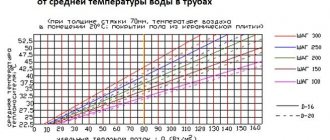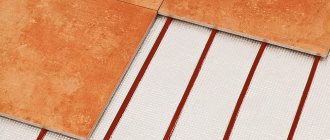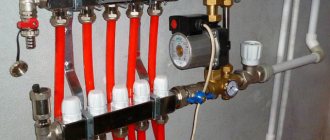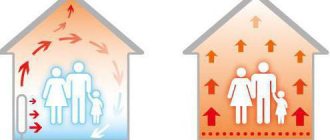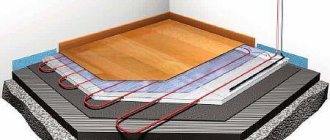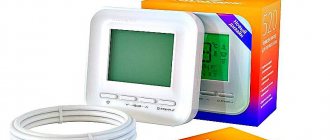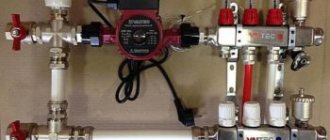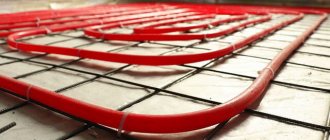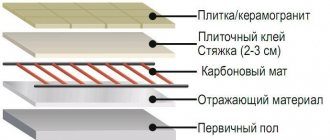What you need to know before installing heated floors
The temperature must not be lower than +18°C. You can, of course, install electric radiators and convectors, but this will cost a pretty penny. It is prohibited to move a water radiator onto a balcony according to the law: “It is prohibited to move radiators into glazed loggias and balconies” (clause 3, clause 1 of “Reconstruction Measures” of Appendix 1 to Resolution No. 73-PP dated 02/08/2005, as amended by No. 883 -PP dated November 15, 2005). And it is very difficult to circumvent the ban on the removal of heating.
Therefore, start with insulating the loggia. Use penoplex, polystyrene foam, etc. Then think about heating the balcony.
Often, warm floors are chosen as this option. The most common heated floor on a loggia or balcony is electric. It comes in cable, matte and infrared. There is also a water floor. Let's look at them all in order.
What other insulation materials are used? Read: Insulation for balconies inside - options. Find out about heating methods on the balcony in this article.
How to insulate the floor, ceiling and walls of the loggia inside? You will find several ways of this, that, and the third at the link:
Choosing material
Before choosing linoleum for a balcony, you need to consider what types of material exist. It is divided according to the types of material from which it is made. And this:
- colloxylin;
- glyphthalic;
- polyvinyl chloride;
- glassine;
- rubber.
The polyvinyl chloride type of material has earned the greatest popularity among consumers. When purchasing, you should pay attention to the availability of additional coverage. The small pores of which will absorb dust. It is also better to take material with a rough surface. To avoid slipping later if the floors are wet.
Polyvinyl chloride linoleum
Cable heated floor for balcony
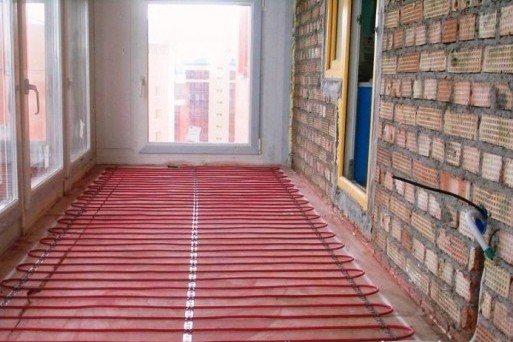
Cable flooring is usually spread over the balcony like a snake
The heating element here is an electrical cable connected to the mains. Placed in a concrete screed, it first warms up the screed, and then it releases heat into the air.
Concrete screed is a prerequisite for the use of cable heated floors. The flooring can be laminate, tile, linoleum.
Advantages of cable floors on the balcony
- The air is heated without drafts, evenly. At floor level the temperature reaches +24°C, in the body area +22°C, in the head area +18°C.
- The screed is capable of accumulating heat according to the principle of a Russian stove, which prevents heat loss.
- Compared to heating with radiators and convectors, cable floors consume 20–50% less electric current.
Disadvantages of cable floors when used on a loggia
- Heating occurs slowly (up to +27 in 30 minutes), because the cable must first warm up the screed.
- The cable creates an electromagnetic field. True, it is not so significant as to seriously fear for your health. Radiation from a mobile phone is an order of magnitude higher.
- When installing an electric heated floor on a balcony, it is necessary to make a concrete screed.
- Large furniture cannot be placed on electric floors. Otherwise, dark spots from overheating will remain on the floor in these places.
To save energy, you need to additionally buy a thermostat. It maintains a given temperature – usually +27°C. And automatically turns off the floor when the temperature reaches this value.
Do you have old aluminum wiring in your home? For fire safety, install a copper cable (with a cross-section of at least 2.5 mm) to the heated floor. It is led directly to a separate electric meter machine.
Cable floors can be single-core or double-core.
Twin-core ones began to be produced relatively recently, and they have a number of advantages. Two conductive wires balance electromagnetic radiation, so the electromagnetic background is practically zero. Installing a two-core cable is a little easier. True, single-core cable is 20% cheaper.

For a single-core cable floor, 2 mounting ends are connected to the thermostat

A two-core cable has only one mounting end
Insulation of the balcony from the outside
How to insulate a balcony from the outside? Holding an event allows you to eliminate the selection of the premises relative to the area. Also, such a solution eliminates the cooling of the walls. But it is worth noting the need to coordinate the project with the authorities due to changes to the facade of the house, if this is not the private sector.
At a height of more than 3 floors, according to the rules, it is permissible to carry out work only with the help of special equipment and permission.
Using the technology, you can make a warm balcony as follows:
- Strengthening the parapet. This can be done using a reinforced frame made of metal profiles, brick or block masonry. A tongue-and-groove slab is less commonly used.
- Preparation of the working surface. The insulated base must be healthy, clean, and durable. Treatment is carried out with protective compounds against fungus, mold (read more in the article “how to get rid of mold on the balcony”) and bacteria, followed by strengthening priming with deep penetration agents. Metal structures are coated with anti-corrosion paints.
- Vapor barrier, insulation. The first is represented by films, membrane fabrics with breathability. They are needed to remove moisture and protect thermal insulation from condensation. If there is a frame, then it is better to choose mineral wool; for a solid base, slabs are more appropriate. Less often, preference is given to plaster, since it is heavier and has relatively high thermal conductivity.

Next, to insulate the balcony, a hydrobarrier is laid on the outside and finishing is carried out. These can be plaster mortars or cladding materials. More often, preference is given to the second solution due to its low weight, wide range and aesthetics.
Read more in the article “Sheathing the balcony from the outside.”
For walls with ceilings, penofol is relevant. This is foamed polyethylene. If there is an aluminum foil coating, then such material better reflects heat into the room. Flooring is used to be placed in front of decorative cladding. Contact with organic solvents must be excluded.
Fixation is carried out without overlap using a stapler, and the seams are glued with metallized tape.
Electric heating mat
A special type of cable flooring that is successfully used on balconies and loggias. Essentially, these are the same single-core or double-core cables, only attached with a snake to a base mesh. This simplifies installation and no screed is required. This mat is easy to install using your own tile adhesive. Once the glue has hardened, the mat can be used immediately.
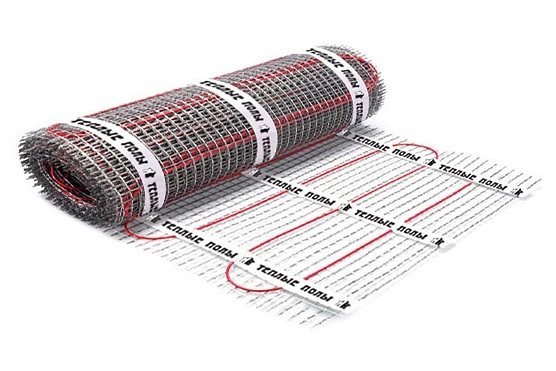
A heating mat is a single-core or two-core cable floor that is “packed” into a mat
Heating mats are suitable for porcelain stoneware, laminate, parquet, linoleum, and carpet. They are considered an ideal option for tiles.
They differ from conventional cable flooring in simpler installation. However, mats are half as expensive as cable floors - with a power above 180 W they cost from 2,500 rubles. per sq. m.
Infrared heated floors
When connected to an electrical outlet, such a floor emits long infrared rays and negatively charged ions. Since all heat is infrared in nature, it can be said that the indication of “infrared” is simply a marketing ploy by manufacturers. The principle of heating is no different from other types of heated floors - they heat the floor covering, and from it the air.
Air ionization is undoubtedly useful. Ions kill fungus, the air becomes cleaner. The only problem is that the entire beneficial effect will be limited to the floor covering. It simply will not let the ions go further.
Manufacturers recommend installing infrared floors under carpet, tile, laminate and wood. But we want to warn you - due to constant heating, the last two coatings may dry out.
Advantages of infrared heated floors
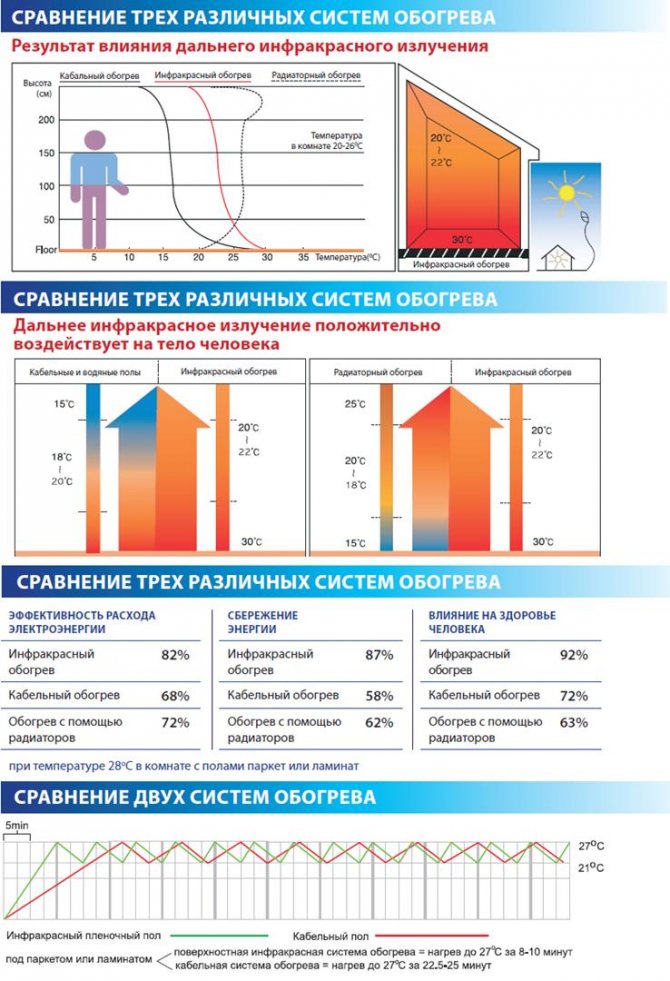
Comparison of three heating systems: cable, infrared floors and radiator
Infrared heated floors are in many ways better than cable ones:
- they heat the air more evenly across the entire height of the room. Near the ceiling it will be +20°C, while cable and water floors warm the top of the room to +15°C
- The thermal conductivity of infrared floors is slightly higher than that of water and cable floors. The heat from the first is transferred by 90% to the floor covering, and only 10% can go to the neighbors below
- infrared floor saves 20% energy compared to cable floors
- heating to the set temperature occurs twice as fast as other floors
- heat transfer does not decrease over time. With proper use, the floor can work like new for many years.
- electrical contacts have a parallel connection circuit. This means that if one section fails, the rest will work without noticeable heat loss
- infrared floor is safe to use. It does not burn, does not freeze, and does not give an electric shock. Electromagnetic radiation is less than that of cable floors - the latter emit it throughout the entire volume of the balcony, and in infrared the current flows only along the edges
- To install such a floor, you do not need permission from the authorities. It is convenient to use in apartment buildings with centralized heating, since installing a water floor there is prohibited by law
- Install easily and quickly in a few hours
- if necessary, they can be collected and spread in a new place
Disadvantages of infrared heated floors

The connection diagram for a warm film floor is not simple
Infrared floors also have disadvantages:
- Difficult to connect electricity. If you cannot connect the contact correctly, you will have to throw it away. And there are a limited number of them included
- film manufacturers assure that it can be laid even on uneven floors
However, it is not. The floor needs to be well leveled so that, again, the contacts are not damaged.
How to make a screed on a balcony, read the material: We make a floor with a screed with our own hands and, most importantly, with high quality. We also have an article on our website with several ways to lay the floor on a balcony. It will come in handy when installing flooring.
If you have not yet chosen a brand of heated floor, follow the link:
Types of infrared heated floors
There are two types of infrared floors - film, which are rolls of thin film, and mats made from heating rods.
Rod infrared floor
These are carbon rods that are connected to each other at both ends by black connecting wires.
Unlike film floors, the core floor must be filled with screed. But spreading it out is also easy—roll it out and you’re done. In addition, you won’t have to level the slab as carefully as you would with film.
Film floor
It comes with heating strips and fully heated.
The rod floor, like the cable floor, is laid in a screed
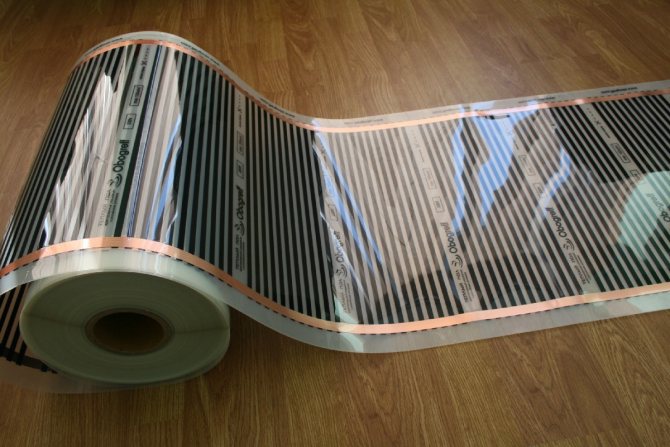
This type of film floor only heats up the black stripes

Here the entire film is heated
In films with heating strips , individual strips placed between polyurethane layers are heated. Depending on the material of the heating element, such films are divided into bimetallic and carbon (carbon).
Externally, the two types differ little from each other. However, bimetallic films are not common now because they are less effective. They have aluminum and copper strips.
The hydrocarbon (carbon) floor heats due to carbon strips. The service life of such floors is 15 years. Cost of 1 sq. m. - from 500 to 1000 rubles.
a solid carbon film in 2011. Its difference is that it does not consist of separate strips, but is a solid carbon layer. The larger the coverage area, the higher the efficiency, that is, heating.
Solid carbon fiber is embedded between layers of polyethylene terephthalate (PET). These layers provide such strength that the film can be cut with a knife, and the heat transfer will remain the same. Therefore, the warranty period for it is 50 years. It is sold in rolls with a width of 50 and 100 cm. The cost is 1 sq. m. m. about 1600 rub.
For balconies, warm film with a power of 180 W and above is suitable. Additionally, you will have to buy: a thermal insulation backing for the film (for example, penophenol or isolon), a thermostat.
Types of systems
Any solution could be used as additional heating, but since we need to make a single heating system, we will have to choose more carefully, taking into account the placement possibilities and heat transfer characteristics. The options may be as follows:
- Water heating circuits.
- Electric heating cables.
- Thermal electric mats.
- Infrared films.
You can immediately make a reservation about water systems. If you have the ability to tap into a general heating riser and the appropriate permission from the management organization, then there is no problem. If there are no such documents and permits, then it is better not to mess with water systems - it is a troublesome matter and can face serious fines for connecting without permits. The remaining options may well be used.
Water heated floor
The heat source in them is hot water. It is taken from the house's water supply system, passed through a gas boiler, and then the hot water flows through pipes laid in a concrete screed or between joists in a wooden floor. The air is heated from the floor. For example, if it is +37°C on the boiler, then +24°C on the floor, +22°C in the air, +15°C near the ceiling.
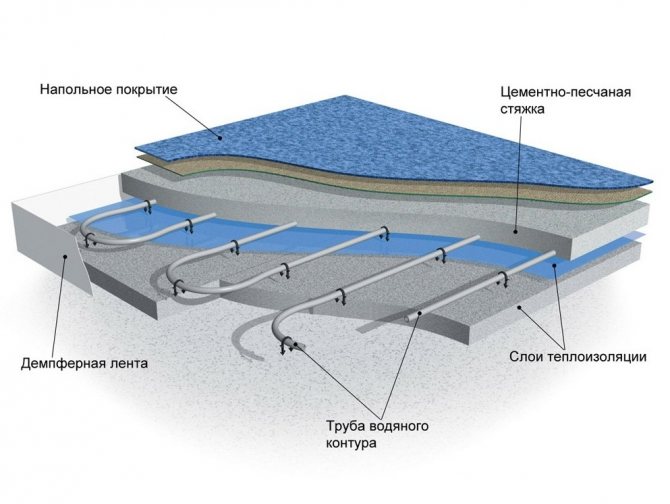
Rubber tubes are used to make a warm water floor
Water-heated floors are suitable for laminate, linoleum, tile, and wood. Basically, water floors are installed in private homes.
If you live in a house with central heating, immediately dismiss water floors as an option. Taking them out onto the balcony for floor heating is prohibited by law. After all, because of them, the neighbors’ water pressure will decrease and the pipes will become colder. If the regulatory services figure this out, there will be a fine and a requirement to remove the structure.
Advantages of water heated floors
- such floors cool down slowly, and individual areas do not overheat
- gas is cheaper than electricity. Therefore, the cost of heating is lower than that of electric floors
- the most environmentally friendly and safe
What is the punishment for illegally removing a water floor? See the material: Rules for the repair of balconies and loggias. Read about installing a water floor in this article.
Problems may arise on the loggia: blowing, freezing of windows, etc. How to avoid such problems if the balcony is insulated and heated, says an expert on our website.
Disadvantages of water heated floors
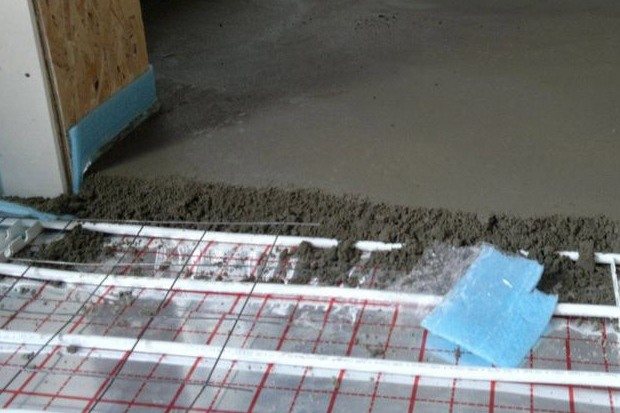
The water floor is laid under a screed, which puts additional load on the balcony
Unfortunately, such a floor has more disadvantages if installed on a balcony.
- heat slowly, because first you need to warm up the screed
- heating by pipes makes the air drier compared to cable and infrared floors
- long and labor-intensive installation
- installation will cost more than electric floors. Installation companies charge for installation and materials - from 600 to 1500 rubles. per sq. m.
- The concrete screed weighs down the balcony. It is equal to the weight of a large motorcycle
- concrete screed adds 3 cm to the floor. Together with thermal insulation pads and floor covering, the floor will increase by 5 - 10 cm.
- If the pipe installation work was carried out poorly, then there is always the possibility of a pipe burst and flooding of the neighbors below. Finding a leak is difficult, you will need to disassemble the screed
Heating cables
In many ways, this system may be the best solution of all. It can be chosen as an independent heating option that does not require additional devices, the operating efficiency is very high, during the installation process a concrete screed is poured and laying linoleum on top of it is not difficult. In addition, the concrete-filled cable gives off heat to the mass of the screed, which, after turning off the heating, will still give off the accumulated heat for some time.
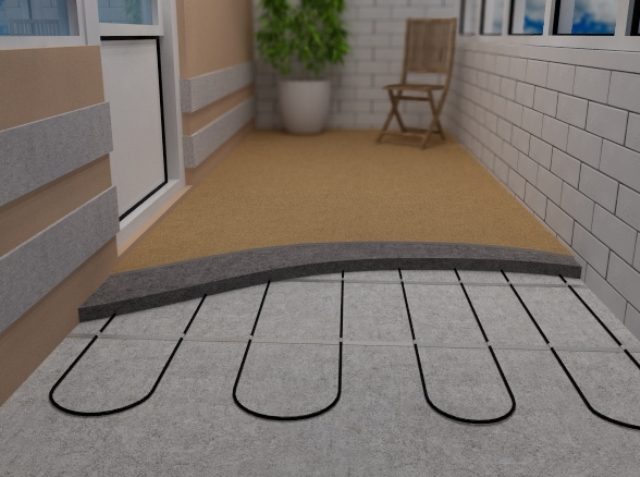
It would seem that the solution is simply excellent, however, it still has some pitfalls. The easiest way is to list them:
- Pouring screed is a difficult and “dirty” process. Not everyone can do everything perfectly and end up with a smooth surface.
- This will take quite a lot of time. In total, it will take about a month for the poured solution to dry completely.
- The poured mass will significantly increase the load on the floor slab, which is not always good.
- The floor will rise by five to seven centimeters.
Increased electricity bills can also be considered a disadvantage, but this is quite natural, since heating occurs due to the heating of the electric cable. With good insulation of all surfaces, electricity bills will not increase so critically.
